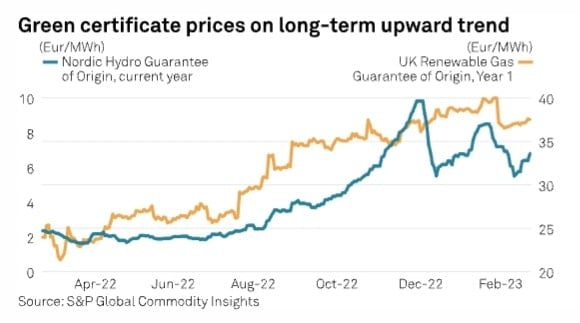A global standard-setter on carbon emissions accounting, Greenhouse Gas Protocol, is set to revise its rules on how entities report their Scope 1, 2, and 3 emissions.
There has been a heated debate about the effectiveness of environmental certificates. In effect, the organization plans to change its rules on reporting all three emissions scopes and has been seeking feedback until March 14.
Scope 1 includes emissions sources directly under the control of an entity. Scope 2 covers indirect emissions from bought power or energy while Scope 3 involves other value chain emissions.
Greenhouse Gas Protocol Guidance
Almost all companies and organizations that report emissions are using the GHG Protocol’s guidance. The organization’s rules helped create a growing market for environmental certificates used by businesses to boost their green credentials.
But a recent contention can change how things have been, especially with renewable energy certificates (RECs).
The main debate centers on what is called market-based accounting. It is a system that allows entities to meet emissions targets through contractual agreements or by buying environmental certificates. This system enables the use of renewable energy certificates in Scope 2 reporting.
- Other certificates – e.g. hydrogen, sustainable aviation fuel (SAF), green steel, and renewable natural gas – are also under contention.
There would be a live debate around the use of renewable energy certificates for Scope 1 and Scope 3 emissions.
New and Tighter Rules
Green certificates values have been in an increasing trend as seen in the graph. That’s mainly due to strong corporate interests in buying them.
But critics are persistently questioning the additionality of those certificates.
- Additionality refers to the extent to which buying a certificate results in creating new renewables that would not otherwise exist.
This concern urged some people to suggest that the Greenhouse Gas Protocol should tighten its rules on certificates’ use in emissions reporting.
Commenting on this issue, a professor of carbon accounting said:
“There will be some form of additionality requirement for market-based Scope 2, and that will reduce demand for non-additional RECs, and increase interest in RECs with additionality, and power purchase agreements…”
The lecturer further suggested excluding market-based accounting from GHG inventories. Instead, there should be separate reporting of the changes due to company actions, including emissions reductions of buying RECs, if and when RECs do reduce emissions.
But a CEO of a renewable energy software firm counters the suggestion saying that it would be not likely that the Protocol would scrap market-based accounting altogether. He noted that:
“They should implement clear constraints on geographical boundaries. Right now, you can buy certificates from anywhere. In Europe, lots of certificates come from Norway. Electricity has some physical constraints and this needs to be acknowledged…”
Another significant suggestion is to make time-stamped certificates and match supply and demand in close to real time. That means hourly accounting method, which is impossible for all to meet.
Response from the Industry
Certificates organizations fought back against the push not to include RECs and other certificates in reporting carbon reductions. They said tighter rules will restrict support for green technologies.
The RECS energy certificates association stated in a position paper:
“Renewable energy markets based on EACs (Energy Attribute Certificates) clearly support additionality, help to accelerate the energy transition, and cut emissions by displacing fossil fuels. Every purchase of renewable energy attributes provides additionality.”
There is also a strong objection to the proposed changes on the rules on biomethane certificates. Over 50 companies have signed a joint letter of objection, including Shell and TotalEnergies.
They stated in the letter that the changes will undermine the emerging market for biomethane certificates. These certificates fund new anaerobic digestion infrastructure that’s capable of tracking biomethane through a gas grid. Their letter also said that:
“…with effective eligibility criteria, certificates can fund the production of additional green gas — breaking the sector’s current reliance on government support — and drive biogas growth to its full potential.”
Impact on the Voluntary Carbon Market
The current emissions reporting standards are separate from guidance on the voluntary carbon market (VCM). Yet, the Greenhouse Gas Protocol still considers carbon offsets or carbon credits as one example of a market-based instrument.
The organization seeks suggestions from survey respondents if carbon offsets should apply in calculating Scope 3 emissions.
Industry experts say that if the market-based method extends to cover Scope 3 emissions, or if the guidance on reporting those emissions changes, the VCM would also be affected.
Currently, the VCM is on a significant transition focusing on integrity and quality initiatives.
Alongside standardization, transparency in carbon credits transactions is also crucial. And some revisions to the guidance can help in promoting that.
Quality and transparency standards for carbon credits are critical as the credibility of some forest projects has come under fire in the public’s eyes.
In response, the Integrity Council for the Voluntary Carbon Market (VCMI) will introduce high-integrity carbon credit labels in the 3rd Qtr of 2023. It will also publish its final Core Carbon Principles (CCPs) next month to make the VCM more transparent, liquid, and high-integrity.
Meanwhile, the VCMI is drafting a consultation meant to bring integrity to corporate claims involving the use of carbon credits.


